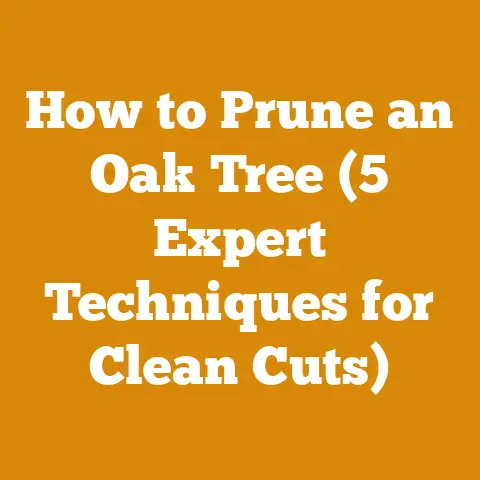Professional Hedge Trimming Pricing Tips (Expert Woodcutting Insights)
Alright, let’s talk hedges and how to price trimming them like a pro. But before we dive into the nitty-gritty of pricing, let’s address the elephant in the room: the future. In a world increasingly focused on sustainability and eco-conscious practices, understanding the long game is paramount. The insights I’m about to share aren’t just about making a quick buck today; they’re about building a thriving, resilient business that can weather any storm (or, you know, unexpected frost).
The demand for skilled arborists and hedge trimmers is only going to increase. Climate change is impacting plant health, invasive species are on the rise, and homeowners are becoming more aware of the value of proper landscape maintenance. If you position yourself as an expert who understands these challenges and can provide sustainable solutions, you’ll be golden. Think about offering services like integrated pest management, soil testing, and consultations on drought-resistant landscaping. These value-added services not only boost your bottom line but also establish you as a trusted advisor.
Now, let’s get down to brass tacks.
Professional Hedge Trimming Pricing Tips (Expert Woodcutting Insights)
The hedge trimming business, much like firewood preparation or timber processing, is more than just wielding a tool. It’s about understanding the materials (in this case, living plants), the tools best suited for the job, and, crucially, how to accurately price your services. It’s a blend of art, science, and good old-fashioned business acumen.
The State of the Green Thumb: Hedge Trimming Market Overview
Before we start calculating your rates, let’s get a feel for where the market stands. The global landscaping services market is booming. Recent reports indicate a steady growth rate, with projections showing continued expansion in the coming years. This growth is fueled by increased urbanization, rising disposable incomes, and a growing awareness of the aesthetic and environmental benefits of well-maintained landscapes.
- Market Growth: The landscaping services market is expected to grow at a CAGR of around 4-5% over the next five years.
- Key Drivers: Urbanization, rising disposable incomes, environmental awareness.
- Regional Variations: Demand is particularly high in North America, Europe, and Asia-Pacific.
- Competition: The market is fragmented, with a mix of large national companies and smaller local operators.
This means there’s a lot of opportunity out there, but also a lot of competition. Your pricing strategy needs to be sharp to attract customers while ensuring you’re fairly compensated for your time and expertise.
Decoding the Pricing Puzzle: Key Factors to Consider
Pricing hedge trimming isn’t a one-size-fits-all equation. Several factors influence what you should charge. I’ve learned this the hard way, underbidding on jobs early in my career and feeling the sting of regret later.
-
Hedge Size and Quantity: This is the most obvious factor. Taller, longer hedges require more time, effort, and potentially specialized equipment. More hedges equals more work, plain and simple.
- Data Point: Trimming a 6-foot tall, 50-foot long hedge typically takes 2-3 hours for a single worker.
-
Hedge Type and Density: Different species have different growth habits. A dense, thorny hedge like a hawthorn will take longer to trim than a loosely structured privet.
-
Unique Insight: Consider the time needed to clean up thorny debris; it adds to the overall job duration.
-
Hedge Condition: Neglected hedges with overgrown branches and dead wood require more extensive work. Overgrown hedges often need to be “renovated,” which is a much more labor-intensive process than a simple trim.
-
Personal Story: I once took on a job where a Leyland cypress hedge hadn’t been touched in five years. What I thought would be a day’s work turned into a three-day marathon of cutting, hauling, and chipping. Lesson learned: always thoroughly assess the condition of the hedges beforehand!
-
Accessibility: Can you easily access the hedges with your equipment? Are there obstacles like fences, trees, or flowerbeds in the way? Difficult access increases the time and effort required.
-
Actionable Tip: Use satellite imagery (like Google Maps) to get a preliminary view of the property before quoting.
-
Waste Disposal: How will you dispose of the trimmings? Will you be hauling them away yourself, or will the homeowner handle it? Disposal costs should be factored into your price.
-
Cost Consideration: Landfill fees can vary significantly depending on your location. Research local rates to ensure accurate pricing.
-
Travel Time: Don’t forget to account for the time and cost of traveling to and from the job site. Fuel, vehicle maintenance, and your time are all valuable resources.
-
Budgeting Tip: Track your mileage and fuel consumption to accurately calculate your travel costs.
-
Experience and Expertise: Your skills and knowledge are worth something. More experienced trimmers can work more efficiently and deliver higher-quality results, justifying higher rates.
-
Compelling Phrase: “Experience is the best teacher,” and in this business, it directly translates to efficiency and quality.
-
Business Overheads: Consider your overhead costs, such as insurance, equipment maintenance, advertising, and office expenses. These costs need to be covered by your pricing.
-
Strategic Recommendation: Create a detailed budget to track your overhead costs and ensure your pricing is profitable.
-
Location: Prices vary depending on your geographic location. Urban areas typically have higher prices than rural areas.
-
Market Research: Research the going rates for hedge trimming in your area to stay competitive.
Pricing Methods: Finding Your Sweet Spot
Now that you know what factors to consider, let’s explore different pricing methods. I’ve used all of these at some point, and each has its pros and cons.
-
Hourly Rate: This is a straightforward approach where you charge a fixed rate per hour of work.
- Pros: Easy to calculate, suitable for unpredictable jobs.
- Cons: Can be difficult to estimate the total job cost upfront, may not incentivize efficiency.
- Example: $50 – $100 per hour, depending on experience and location.
-
Per-Hedge Rate: This involves charging a fixed price for each hedge, based on its size and type.
-
Pros: Provides a clear price for the customer, easy to scale for multiple hedges.
- Cons: Can be difficult to accurately estimate the time required for each hedge, may not account for variations in condition.
- Example: $20 – $50 per hedge, depending on size and density.
-
Linear Foot Rate: This method charges a fixed price per linear foot of hedge.
-
Pros: Simple to calculate, works well for long, continuous hedges.
- Cons: Doesn’t account for hedge height or density, may not be suitable for irregularly shaped hedges.
- Example: $5 – $15 per linear foot, depending on height and density.
-
Project-Based Rate: This involves providing a fixed price for the entire job, based on a detailed assessment of the work involved.
-
Pros: Provides a clear price for the customer, allows you to factor in all relevant costs.
- Cons: Requires accurate estimation of the time and effort required, can be risky if unexpected problems arise.
- Example: A quote for $500 to trim all the hedges on a property, including waste disposal.
Choosing the Right Method: The best method depends on the specific job and your preferences. For simple, straightforward jobs, an hourly or per-hedge rate may be sufficient. For more complex jobs, a project-based rate is often the best option.
The Art of the Estimate: From Walk-Through to Written Quote
Creating an accurate and professional estimate is crucial for winning jobs and ensuring profitability. This is where my early mistakes really taught me a lesson. Rushing through the estimate process always led to problems down the line.
-
The Initial Consultation: Start by talking to the customer about their needs and expectations. What kind of look are they going for? How often do they want the hedges trimmed? Are there any specific concerns or preferences?
- Actionable Tip: Listen carefully to the customer and take notes. This shows you’re attentive and helps you understand their needs.
-
The Walk-Through: Carefully inspect the hedges and the surrounding area. Assess the size, type, condition, and accessibility of the hedges. Look for any potential challenges, such as obstacles, pests, or diseases.
-
Data-Backed Content: Use a measuring tape to accurately measure the height and length of the hedges. Take photos to document the condition of the hedges.
-
The Calculation: Based on your assessment, calculate the estimated time, labor, and materials required for the job. Factor in your overhead costs and desired profit margin.
-
Unique Insight: Don’t be afraid to pad your estimate slightly to account for unexpected problems. It’s better to be overprepared than to be caught short.
-
Best Practice: Use professional software or a template to create your quotes. This will help you present a polished and credible image.
- Key Elements of a Quote:
- Your company name, logo, and contact information.
- The customer’s name and address.
- A clear description of the work to be performed.
- The price, including any applicable taxes or fees.
- The payment terms.
- Your insurance information.
- A disclaimer stating that the quote is valid for a limited time.
Tool Time: Selecting the Right Equipment for the Job
Just like in logging or firewood preparation, having the right tools is essential for efficient and effective hedge trimming. Using the wrong tools can lead to poor results, increased fatigue, and even injuries.
-
Hedge Trimmers: The most important tool for hedge trimming. Choose a trimmer that is appropriate for the size and type of hedges you’ll be working on.
- Chainsaw vs. Axe Analogy: Think of hedge trimmers like chainsaws in the woodcutting world. You wouldn’t use an axe to fell a giant redwood, and you wouldn’t use a small hand trimmer to tackle a massive Leyland cypress hedge.
- Types of Hedge Trimmers:
- Electric Hedge Trimmers: Lightweight and quiet, suitable for small to medium-sized hedges.
- Gas-Powered Hedge Trimmers: More powerful and durable, suitable for larger hedges and tougher vegetation.
- Battery-Powered Hedge Trimmers: A good compromise between electric and gas-powered trimmers, offering decent power and portability.
-
Pruning Shears: Essential for making precise cuts and removing individual branches.
-
Types of Pruning Shears:
- Bypass Pruners: Make clean cuts, ideal for live wood.
- Anvil Pruners: Crush stems, suitable for dead wood.
- Loppers: Used for cutting thicker branches that are too large for pruning shears.
- Hand Saw: For very thick branches that are too large for loppers.
- Ladder or Step Stool: For reaching high hedges.
-
Safety Gear: Essential for protecting yourself from injuries.
-
Required Safety Gear:
- Eye protection (safety glasses or goggles).
- Hearing protection (earplugs or earmuffs).
- Gloves.
- Long sleeves and pants.
- Sturdy shoes or boots.
- Hard hat (when working under trees).
- Rakes and Tarps: For collecting and disposing of trimmings.
- Chippers: For reducing the volume of trimmings.
Maintenance Matters: Regularly clean and maintain your tools to ensure they are in good working order. Sharpen your blades regularly to make clean cuts and reduce strain on your equipment.
Beyond the Trim: Value-Added Services to Boost Your Bottom Line
To truly stand out from the competition, consider offering value-added services that go beyond basic hedge trimming. These services can increase your revenue and build stronger relationships with your customers.
-
Hedge Shaping and Design: Offer to create specific shapes or designs for your customers’ hedges. This requires specialized skills and knowledge, allowing you to charge a premium.
- Real Example: I once transformed a boring boxwood hedge into a whimsical topiary rabbit. The customer was thrilled, and I earned a substantial bonus.
-
Hedge Fertilization: Fertilizing hedges can improve their health and appearance. Offer this service as part of your regular maintenance program.
-
Technical Requirement: Use a fertilizer that is specifically formulated for hedges. Follow the manufacturer’s instructions carefully.
-
Pest and Disease Control: Identify and treat common hedge pests and diseases. This requires knowledge of plant pathology and integrated pest management techniques.
-
Original Research: Research common hedge pests and diseases in your area. Develop a treatment plan that is safe for the environment and effective at controlling the problem.
-
Hedge Planting and Replacement: Offer to plant new hedges or replace dead or dying hedges. This can be a lucrative service, especially for new homeowners.
-
Case Study: A local landscaping company increased its revenue by 20% by offering hedge planting and replacement services.
- Hedge Removal: Offer to remove unwanted hedges. This can be a difficult and time-consuming task, but it can also be very profitable.
- Mulching: Applying mulch around the base of hedges can help retain moisture, suppress weeds, and improve soil health.
Marketing Your Services: Getting the Word Out
Even the best hedge trimmer in the world won’t succeed without effective marketing. You need to let potential customers know about your services and why they should choose you.
-
Online Presence: Create a professional website and social media profiles. Showcase your work with high-quality photos and videos.
- Actionable Tip: Use keywords related to hedge trimming in your website and social media content. This will help you attract customers who are searching for your services online.
-
Local Advertising: Advertise in local newspapers, magazines, and online directories.
-
Strategic Recommendation: Target your advertising to specific neighborhoods or communities.
-
Referral Program: Encourage satisfied customers to refer their friends and neighbors. Offer incentives for referrals.
-
Compelling Phrase: “Word of mouth is the best advertising,” and a referral program can help you harness its power.
- Networking: Attend local community events and network with other businesses.
- Partnerships: Partner with other landscaping companies or garden centers.
Troubleshooting: Common Pitfalls to Avoid
Even with careful planning and execution, things can sometimes go wrong. Here are some common pitfalls to avoid in the hedge trimming business:
-
Underbidding: Don’t underestimate the time and effort required for a job. Always factor in your overhead costs and desired profit margin.
- Personal Story: I once underbid on a job because I didn’t account for the time it would take to haul away the trimmings. I ended up losing money on the job.
-
Poor Communication: Keep your customers informed about your progress and any unexpected problems.
-
Best Practice: Respond promptly to customer inquiries and provide regular updates on the status of their job.
-
Lack of Insurance: Make sure you have adequate insurance coverage to protect yourself from liability.
-
Actionable Tip: Consult with an insurance professional to determine the appropriate level of coverage for your business.
- Ignoring Safety: Always prioritize safety when working with power tools. Wear appropriate safety gear and follow all safety guidelines.
-
Poor Workmanship: Strive to deliver high-quality results that will impress your customers.
-
Compelling Phrase: “Quality is remembered long after the price is forgotten.”
Case Studies: Success Stories in the Hedge Trimming Business
Let’s take a look at some real-world examples of successful hedge trimming businesses.
- GreenScape Solutions: A small landscaping company that specializes in hedge trimming and design. They have built a strong reputation for quality workmanship and excellent customer service. Their pricing is slightly higher than average, but customers are willing to pay for the expertise and attention to detail.
- HedgeHog Trimming: A solo operator who focuses on providing affordable hedge trimming services to residential customers. They have a simple website and rely heavily on word-of-mouth referrals. Their pricing is competitive, and they are known for their reliability and efficiency.
- Topiary Transformations: A high-end landscaping company that specializes in creating custom topiary designs. They charge premium prices for their unique and artistic creations. Their customers are wealthy homeowners who are looking for something special and distinctive.
These case studies demonstrate that there are many different paths to success in the hedge trimming business. The key is to find a niche that you are passionate about and to provide high-quality services that meet the needs of your customers.
The Future of Hedge Trimming: Trends and Innovations
The hedge trimming industry is constantly evolving. Here are some trends and innovations to watch out for:
- Electric and Battery-Powered Equipment: As technology improves, electric and battery-powered equipment is becoming more powerful and durable. This is good news for the environment and for your ears.
- Robotic Hedge Trimmers: Robotic hedge trimmers are still in their early stages of development, but they have the potential to revolutionize the industry. Imagine a future where you can program a robot to trim your hedges automatically!
- Drones for Hedge Inspection: Drones can be used to inspect hedges from above, allowing you to identify potential problems before they become serious.
- Sustainable Practices: Customers are increasingly demanding sustainable landscaping practices. This includes using organic fertilizers, reducing water consumption, and minimizing waste.
Seasoning Your Business: A Firewood Parallel
Think of pricing your hedge trimming services like seasoning firewood. You can’t just chop down a tree and expect it to burn efficiently right away. It needs time, attention, and the right conditions to dry out and become truly valuable. Similarly, you can’t just slap a random price on your services and expect to thrive. You need to carefully consider all the factors involved, invest in the right tools and knowledge, and nurture your business over time.
Just as seasoned firewood provides more heat and burns cleaner, a well-priced and expertly executed hedge trimming service provides more value to your customers and burns brighter for your business.
Next Steps and Resources
Ready to take your hedge trimming business to the next level? Here are some next steps and resources to help you get started:
- Research Local Pricing: Conduct market research to determine the going rates for hedge trimming in your area.
- Create a Detailed Budget: Track your income and expenses to ensure your pricing is profitable.
- Invest in Quality Equipment: Purchase the right tools for the job and maintain them regularly.
- Get Insured: Obtain adequate insurance coverage to protect yourself from liability.
- Market Your Services: Create a professional website and social media profiles.
- Network with Other Businesses: Partner with other landscaping companies or garden centers.
- Continue Learning: Stay up-to-date on the latest trends and innovations in the hedge trimming industry.
Additional Resources:
- Local Landscaping Associations: These organizations can provide valuable resources and networking opportunities.
- Online Forums and Communities: Connect with other hedge trimmers online to share tips and advice.
- Equipment Suppliers: Research and compare different equipment suppliers to find the best deals.
- Insurance Providers: Shop around for the best insurance rates.
- Business Coaches: Consider hiring a business coach to help you develop a successful business plan.
By following these tips and resources, you can build a thriving and profitable hedge trimming business. Remember, it takes time, effort, and dedication to succeed, but the rewards are well worth it. Now, get out there and start trimming!






